wheel PEUGEOT 4008 2014 User Guide
[x] Cancel search | Manufacturer: PEUGEOT, Model Year: 2014, Model line: 4008, Model: PEUGEOT 4008 2014Pages: 368, PDF Size: 20.33 MB
Page 40 of 368
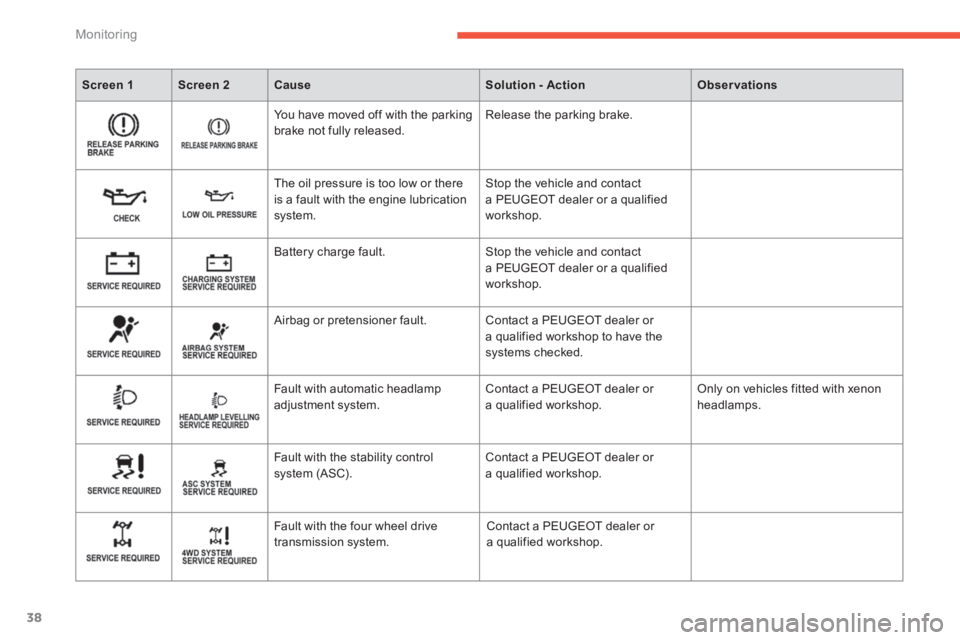
38
Monitoring
Screen 1
Screen 2
Cause
Solution - Action
Observations
You have moved off with the parking
brake not fully released. Release the parking brake.
The oil pressure is too low or there
is a fault with the engine lubrication
system. Stop the vehicle and contact
a PEUGEOT dealer or a qualified
workshop.
Battery charge fault. Stop the vehicle and contact
a PEUGEOT dealer or a qualified
workshop.
Airbag or pretensioner fault. Contact a PEUGEOT dealer or
a qualified workshop to have the
systems checked.
Fault with automatic headlamp
adjustment system. Contact a PEUGEOT dealer or
a qualified workshop. Only on vehicles fitted with xenon
headlamps.
Fault with the stability control
system (ASC). Contact a PEUGEOT dealer or
a qualified workshop.
Fault with the four wheel drive
transmission system. Contact a PEUGEOT dealer or
a qualified workshop.
Page 41 of 368
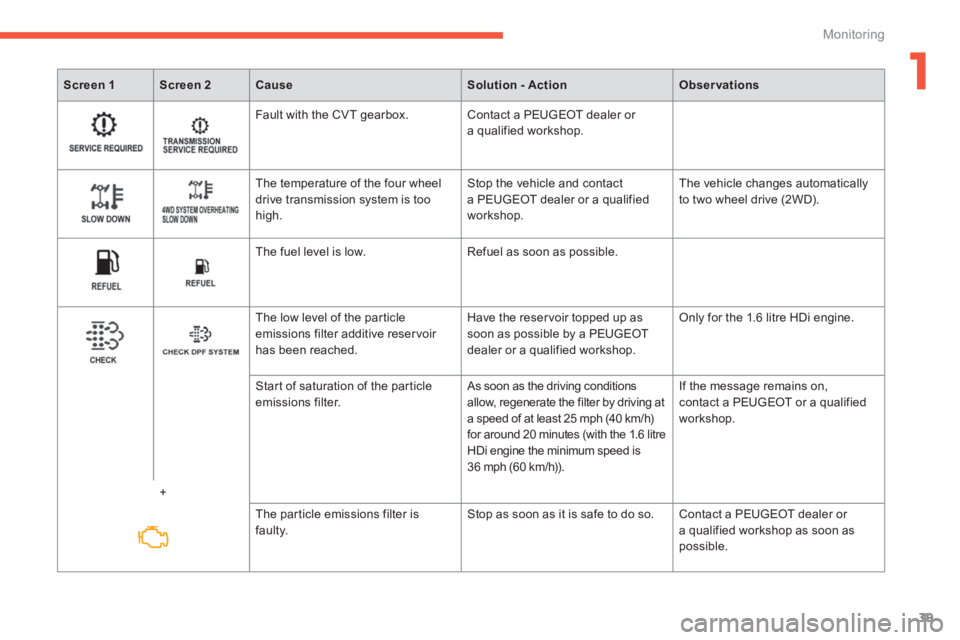
1
39
Monitoring
Screen 1
Screen 2
Cause
Solution - Action
Observations
Fault with the CVT gearbox. Contact a PEUGEOT dealer or
a qualified workshop.
The temperature of the four wheel
drive transmission system is too
high. Stop the vehicle and contact
a PEUGEOT dealer or a qualified
workshop. The vehicle changes automatically
to two wheel drive (2WD).
The fuel level is low. Refuel as soon as possible.
The low level of the particle
emissions filter additive reser voir
has been reached. Have the reser voir topped up as
soon as possible by a PEUGEOT
dealer or a qualified workshop. Only for the 1.6 litre HDi engine.
+ Start of saturation of the particle
emissions filter. As soon as the driving conditions
allow, regenerate the filter by driving at
a speed of at least 25 mph (40 km/h)
for around 20 minutes (with the 1.6 litre
HDi engine the minimum speed is
36 mph (60 km/h)). If the message remains on,
contact a PEUGEOT or a qualified
workshop.
The particle emissions filter is
faulty. Stop as soon as it is safe to do so. Contact a PEUGEOT dealer or
a qualified workshop as soon as
possible.
Page 43 of 368
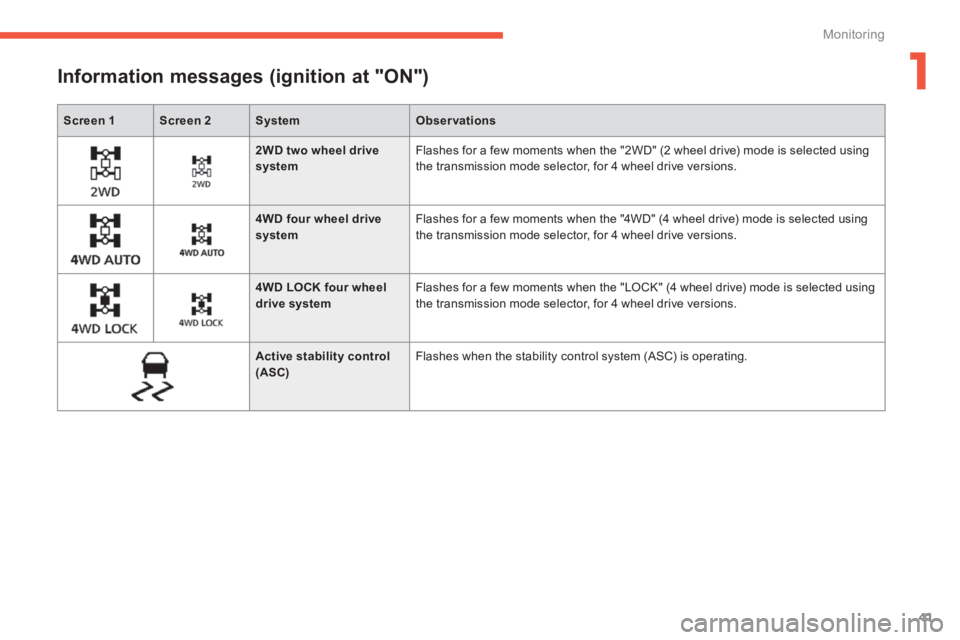
1
41
Monitoring
Screen 1
Screen 2
System
Observations
Information messages (ignition at "ON")
2WD two wheel drive
system
Flashes for a few moments when the "2WD" (2 wheel drive) mode is selected using
the transmission mode selector, for 4 wheel drive versions.
4WD four wheel drive
system
Flashes for a few moments when the "4WD" (4 wheel drive) mode is selected using
the transmission mode selector, for 4 wheel drive versions.
4WD LOCK four wheel
drive system
Flashes for a few moments when the "LOCK" (4 wheel drive) mode is selected using
the transmission mode selector, for 4 wheel drive versions.
Active stability control
(ASC)
Flashes when the stability control system (ASC) is operating.
Page 91 of 368
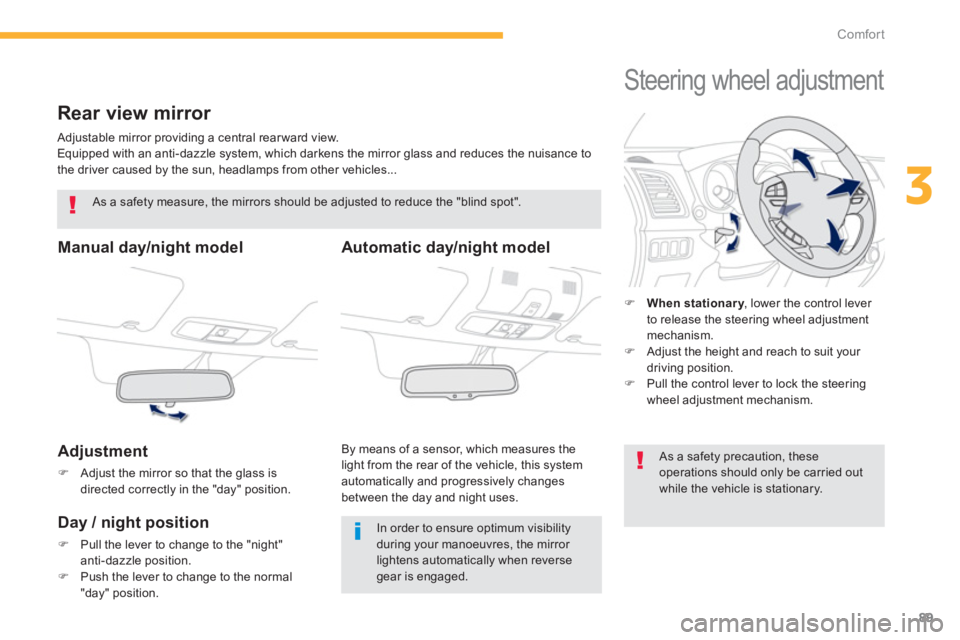
89
3
Comfort
Rear view mirror
Adjustable mirror providing a central rear ward view.
Equipped with an anti-dazzle system, which darkens the mirror glass and reduces the nuisance to
the driver caused by the sun, headlamps from other vehicles...
Manual day/night model
Adjustment
�)
Adjust the mirror so that the glass is
directed correctly in the "day" position.
As a safety measure, the mirrors should be adjusted to reduce the "blind spot".
In order to ensure optimum visibility
during your manoeuvres, the mirror
lightens automatically when reverse
gear is engaged.
Day / night position
�)
Pull the lever to change to the "night"
anti-dazzle position.
�)
Push the lever to change to the normal
"day" position.
Automatic day/night model
By means of a sensor, which measures the
light from the rear of the vehicle, this system
automatically and progressively changes
between the day and night uses.
Steering wheel adjustment
�)
When stationary
, lower the control lever
to release the steering wheel adjustment
mechanism.
�)
Adjust the height and reach to suit your
driving position.
�)
Pull the control lever to lock the steering
wheel adjustment mechanism.
As a safety precaution, these
operations should only be carried out
while the vehicle is stationary.
Page 110 of 368
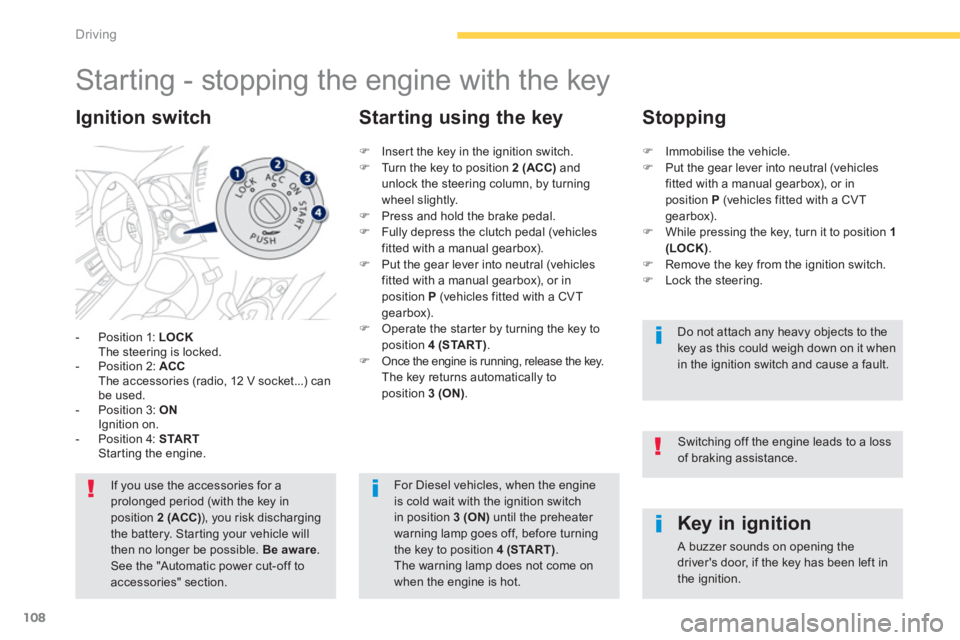
108
Driving
Starting - stopping the engine with the key
- Position 1: LOCK
The steering is locked.
- Position 2: ACC
The accessories (radio, 12 V socket...) can
be used.
- Position 3: ON
Ignition on.
- Position 4: START
Starting the engine.
Ignition switch
If you use the accessories for a
prolonged period (with the key in
position 2 (ACC)
), you risk discharging
the battery. Starting your vehicle will
then no longer be possible. Be aware
.
See the "Automatic power cut-off to
accessories" section.
Key in ignition
A buzzer sounds on opening the
driver's door, if the key has been left in
the ignition.
�)
Insert the key in the ignition switch.
�)
Turn the key to position 2 (ACC)
and
unlock the steering column, by turning
wheel slightly.
�)
Press and hold the brake pedal.
�)
Fully depress the clutch pedal (vehicles
fitted with a manual gearbox).
�)
Put the gear lever into neutral (vehicles
fitted with a manual gearbox), or in
position P
(vehicles fitted with a CVT
gearbox).
�)
Operate the starter by turning the key to
position 4 (START)
.
�)
Once the engine is running, release the key.
The key returns automatically to
position 3 (ON)
.
Starting using the key
Stopping
�)
Immobilise the vehicle.
�)
Put the gear lever into neutral (vehicles
fitted with a manual gearbox), or in
position P
(vehicles fitted with a CVT
gearbox).
�)
While pressing the key, turn it to position 1
(LOCK)
.
�)
Remove the key from the ignition switch.
�)
Lock the steering.
Do not attach any heavy objects to the
key as this could weigh down on it when
in the ignition switch and cause a fault.
For Diesel vehicles, when the engine
is cold wait with the ignition switch
in position 3 (ON)
until the preheater
warning lamp goes off, before turning
the key to position 4 (START)
.
The warning lamp does not come on
when the engine is hot.
Switching off the engine leads to a loss
of braking assistance.
Page 112 of 368
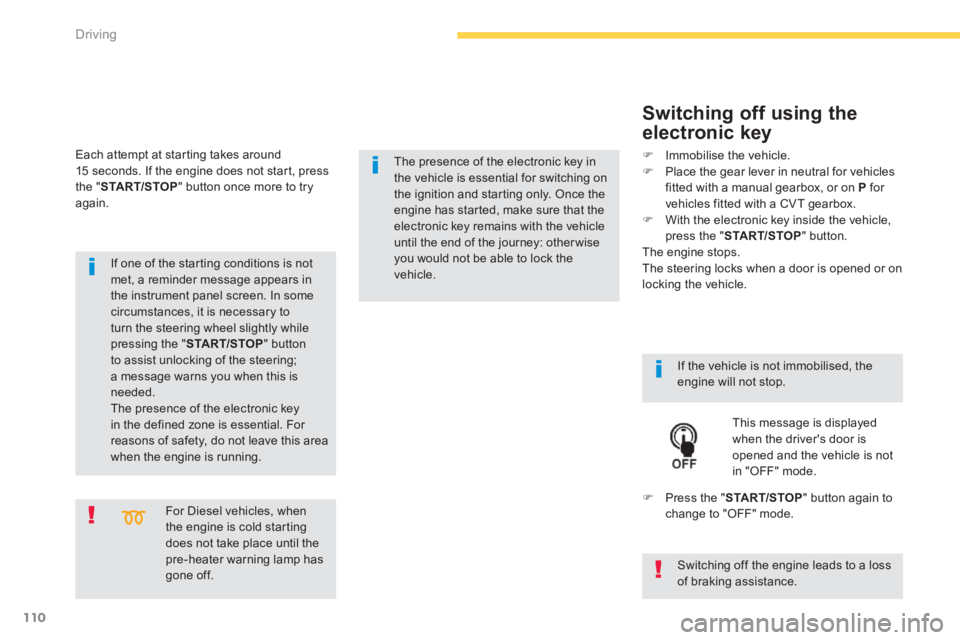
110
Driving
For Diesel vehicles, when
the engine is cold starting
does not take place until the
pre-heater warning lamp has
gone off.
If one of the starting conditions is not
met, a reminder message appears in
the instrument panel screen. In some
circumstances, it is necessary to
turn the steering wheel slightly while
pressing the " START/STOP
" button
to assist unlocking of the steering;
a message warns you when this is
needed.
The presence of the electronic key
in the defined zone is essential. For
reasons of safety, do not leave this area
when the engine is running.
Switching off using the
electronic key
If the vehicle is not immobilised, the
engine will not stop.
This message is displayed
when the driver's door is
opened and the vehicle is not
in "OFF" mode.
�)
Press the " START/STOP
" button again to
change to "OFF" mode.
�)
Immobilise the vehicle.
�)
Place the gear lever in neutral for vehicles
fitted with a manual gearbox , or on P
for
vehicles fitted with a CVT gearbox .
�)
With the electronic key inside the vehicle,
press the " START/STOP
" button.
The engine stops.
The steering locks when a door is opened or on
locking the vehicle.
Each attempt at starting takes around
15 seconds. If the engine does not start, press
the " START/STOP
" button once more to try
again.
The presence of the electronic key in
the vehicle is essential for switching on
the ignition and starting only. Once the
engine has started, make sure that the
electronic key remains with the vehicle
until the end of the journey: other wise
you would not be able to lock the
vehicle.
Switching off the engine leads to a loss
of braking assistance.
Page 114 of 368
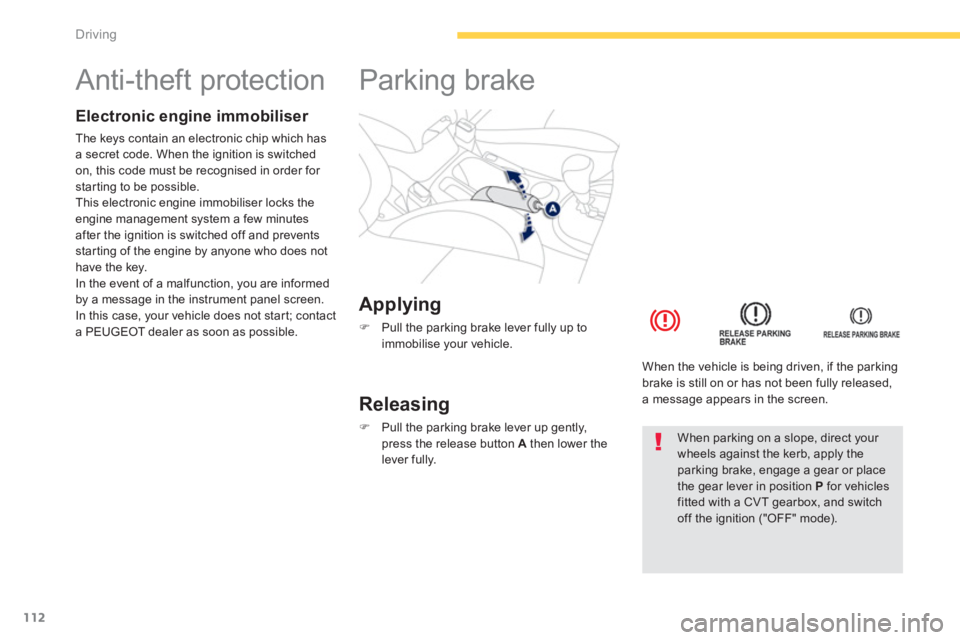
112
Driving
Anti-theft protection
Electronic engine immobiliser
The keys contain an electronic chip which has
a secret code. When the ignition is switched
on, this code must be recognised in order for
starting to be possible.
This electronic engine immobiliser locks the
engine management system a few minutes
after the ignition is switched off and prevents
starting of the engine by anyone who does not
have the key.
In the event of a malfunction, you are informed
by a message in the instrument panel screen.
In this case, your vehicle does not start; contact
a PEUGEOT dealer as soon as possible.
Applying
�)
Pull the parking brake lever fully up to
immobilise your vehicle.
Parking brake
Releasing
�)
Pull the parking brake lever up gently,
press the release button A
then lower the
lever fully.
When the vehicle is being driven, if the parking
brake is still on or has not been fully released,
a message appears in the screen.
When parking on a slope, direct your
wheels against the kerb, apply the
parking brake, engage a gear or place
the gear lever in position P
for vehicles
fitted with a CVT gearbox, and switch
off the ignition ("OFF" mode).
Page 126 of 368
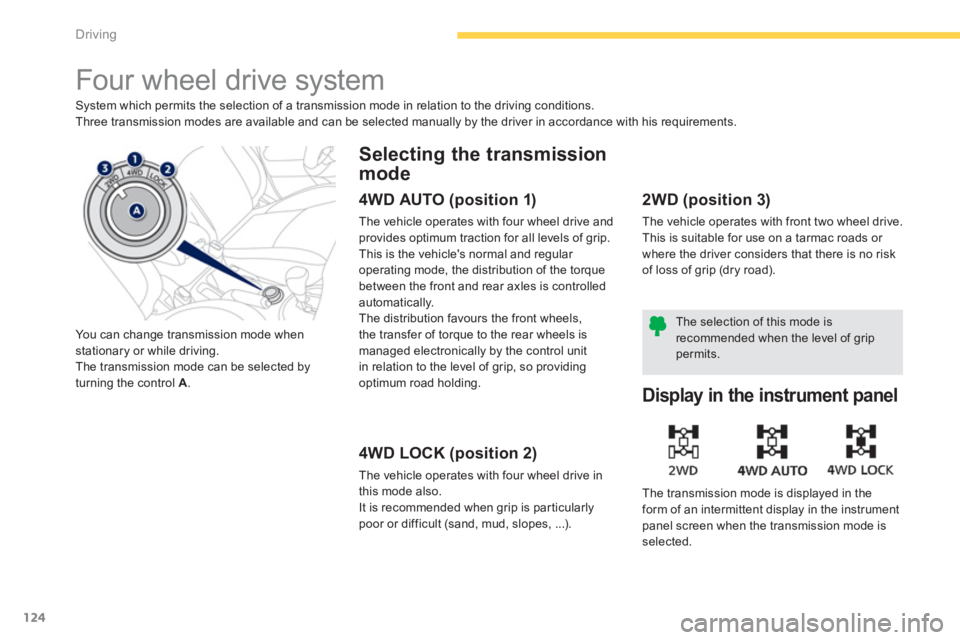
124
Driving
Four wheel drive system
System which permits the selection of a transmission mode in relation to the driving conditions.
Three transmission modes are available and can be selected manually by the driver in accordance with his requirements.
You can change transmission mode when
stationary or while driving.
The transmission mode can be selected by
turning the control A
.
Selecting the transmission
mode
4WD AUTO (position 1)
The vehicle operates with four wheel drive and
provides optimum traction for all levels of grip.
This is the vehicle's normal and regular
operating mode, the distribution of the torque
between the front and rear axles is controlled
automatically.
The distribution favours the front wheels,
the transfer of torque to the rear wheels is
managed electronically by the control unit
in relation to the level of grip, so providing
optimum road holding.
4WD LOCK (position 2)
The vehicle operates with four wheel drive in
this mode also.
It is recommended when grip is particularly
poor or difficult (sand, mud, slopes, ...).
2WD (position 3)
The vehicle operates with front two wheel drive.
This is suitable for use on a tarmac roads or
where the driver considers that there is no risk
of loss of grip (dry road).
Display in the instrument panel
The transmission mode is displayed in the
form of an intermittent display in the instrument
panel screen when the transmission mode is
selected. The selection of this mode is
recommended when the level of grip
permits.
Page 127 of 368
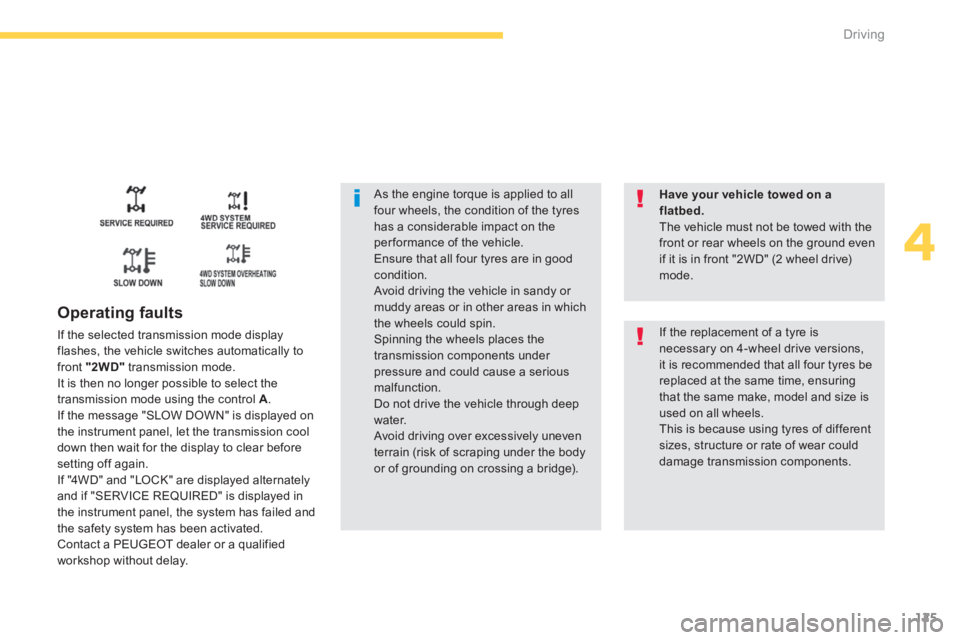
125
4
Driving
As the engine torque is applied to all
four wheels, the condition of the tyres
has a considerable impact on the
per formance of the vehicle.
Ensure that all four tyres are in good
condition.
Avoid driving the vehicle in sandy or
muddy areas or in other areas in which
the wheels could spin.
Spinning the wheels places the
transmission components under
pressure and could cause a serious
malfunction.
Do not drive the vehicle through deep
water.
Avoid driving over excessively uneven
terrain (risk of scraping under the body
or of grounding on crossing a bridge).
Operating faults
If the selected transmission mode display
flashes, the vehicle switches automatically to
front "2WD"
transmission mode.
It is then no longer possible to select the
transmission mode using the control A
.
If the message "SLOW DOWN" is displayed on
the instrument panel, let the transmission cool
down then wait for the display to clear before
setting off again.
If "4WD" and "LOCK" are displayed alternately
and if "SERVICE REQUIRED" is displayed in
the instrument panel, the system has failed and
the safety system has been activated.
Contact a PEUGEOT dealer or a qualified
workshop without delay.
Have your vehicle towed on a
flatbed.
The vehicle must not be towed with the
front or rear wheels on the ground even
if it is in front "2WD" (2 wheel drive)
mode.
If the replacement of a tyre is
necessary on 4-wheel drive versions,
it is recommended that all four tyres be
replaced at the same time, ensuring
that the same make, model and size is
used on all wheels.
This is because using tyres of different
sizes, structure or rate of wear could
damage transmission components.
Page 128 of 368
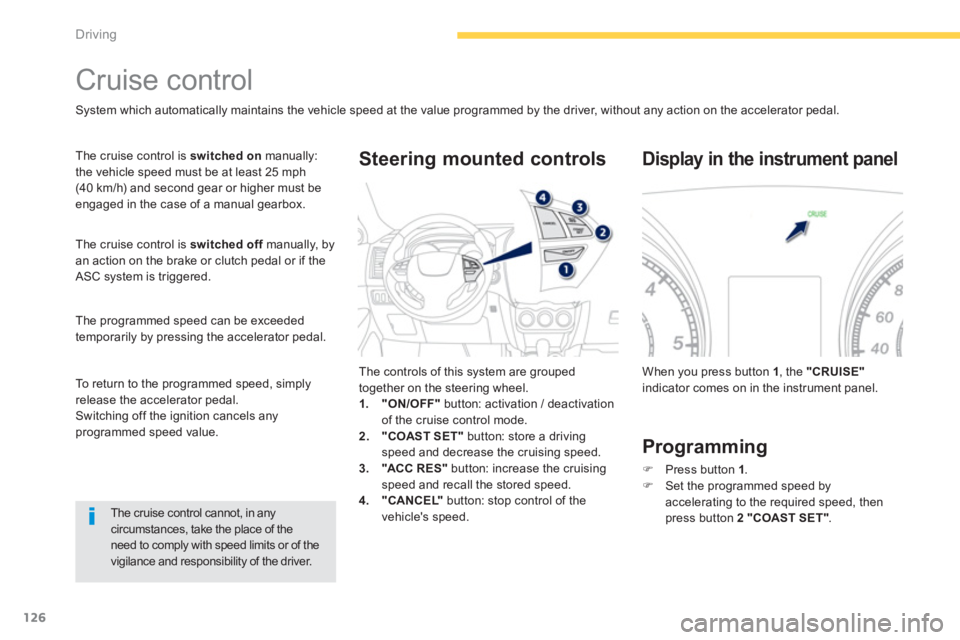
126
Driving
Cruise control
System which automatically maintains the vehicle speed at the value programmed by the driver, without any action on the accelerator pedal.
The cruise control is switched on
manually:
the vehicle speed must be at least 25 mph
(40 km/h) and second gear or higher must be
engaged in the case of a manual gearbox.
The cruise control is switched off
manually, by
an action on the brake or clutch pedal or if the
ASC system is triggered.
The programmed speed can be exceeded
temporarily by pressing the accelerator pedal.
The cruise control cannot, in any
circumstances, take the place of the
need to comply with speed limits or of the
vigilance and responsibility of the driver. The controls of this system are grouped
together on the steering wheel.
1.
"ON/OFF"
button: activation / deactivation
of the cruise control mode.
2.
"COAST SET"
button: store a driving
speed and decrease the cruising speed.
3.
"ACC R ES "
button: increase the cruising
speed and recall the stored speed.
4.
"CANCEL"
button: stop control of the
vehicle's speed.
Steering mounted controls
When you press button 1
, the "CRUISE"
indicator comes on in the instrument panel.
Display in the instrument panel
Programming
�)
Press button 1
.
�)
Set the programmed speed by
accelerating to the required speed, then
press button 2 "COAST SET"
.
To return to the programmed speed, simply
release the accelerator pedal.
Switching off the ignition cancels any
programmed speed value.